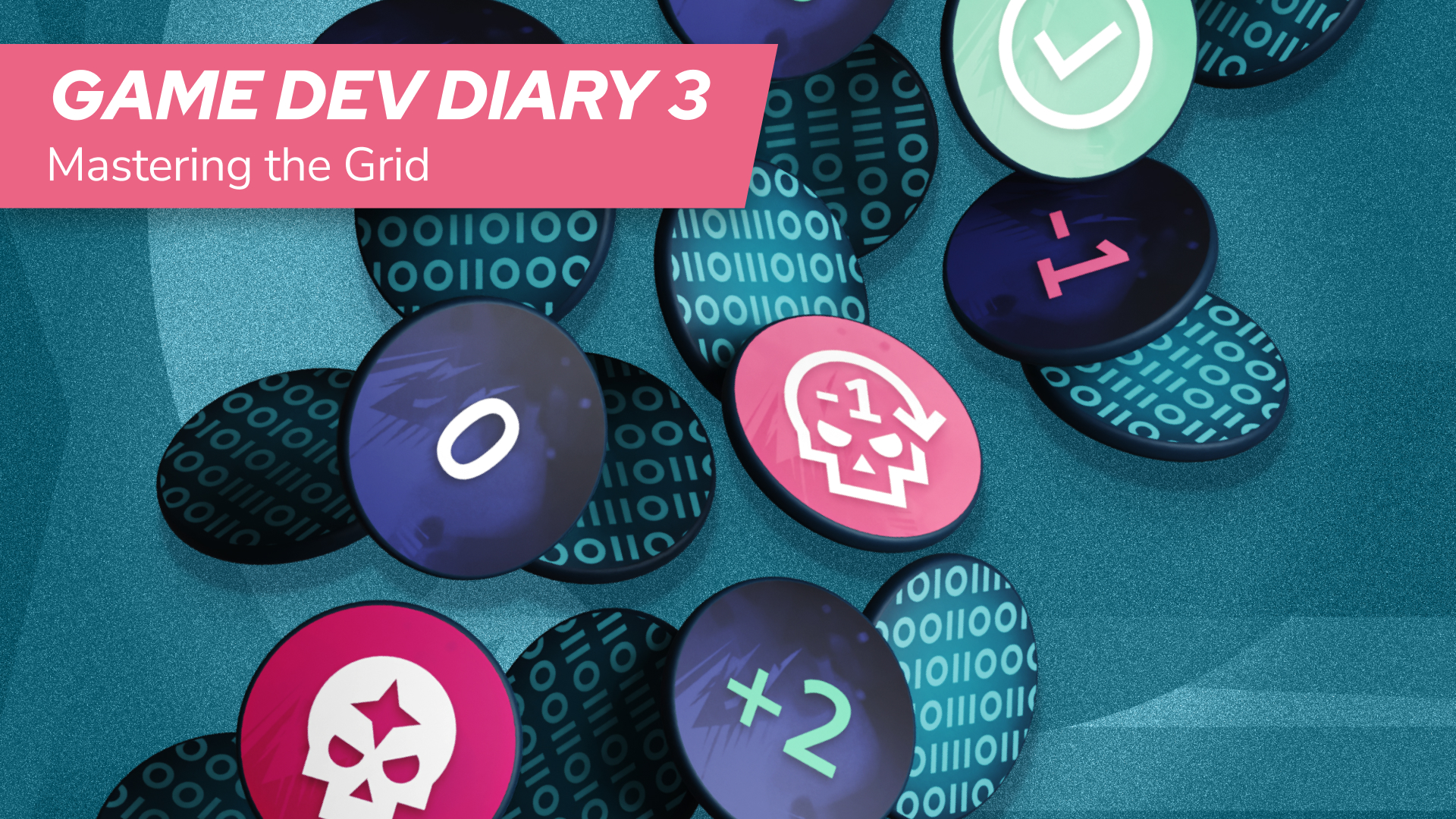Hello everyone!
Here is Francesco again. Previously I talked about the progression system, and last week Dominik & Richi Anna previewed the “A Hopeful Cause” expansion. Today I’m diving into a cornerstone of NEON HOPE’s game design: the Grid.

What is the Grid?
Whenever you perform a task, you must reveal one modifier from the Grid to modify your attribute and find out if you succeed or fail. It is basically the die of NEON HOPE or its “random number generator” if we are talking jargon.

The Grid’s distinctive features come from how it is constructed: At the beginning of the game 19 modifiers are shuffled and 16 of them are arranged in a 4×4 grid. The remaining 3 modifiers are set aside into a zone called the Archive. Whenever a modifier from the Grid is revealed, it stays revealed until all 16 modifiers have been flipped. Only then the Grid is reset. Reshuffle all modifiers (including the ones in the Archive) and place 3 new ones into the Archive.
The number modifiers in the Grid range from -3 to +3. There are also the Epic Win (you immediately succeed and get an additional Impact), the Epic Fail (you immediately fail and activate Enemies), and 3 Skulls (you get -1, reveal an additional modifier, and activate Enemies).

Why is the Grid a Good Fit for NEON HOPE?
The Grid was chosen over other methods to generate random numbers for two reasons:
- Fairness: As you reveal almost all modifiers, the extent of fortunate and unfortunate outcomes is limited. You could be unlucky and reveal the Epic Fail, a -3, and another -3 during your first turn. But now these modifiers are out of the equation for a while and your future actions are inevitably going to succeed more likely.
- Predictability: As modifiers are revealed, you get an idea of which modifiers are still in the Grid. Players can use this to their advantage. For example: a Grid where all remaining modifiers are negative should be approached with different strategies than one that just has been reset.
These features support the theme of NEON HOPE and the style of play we want to encourage.
- NEON HOPE promises that there is hope in the face of despair. Even if it is tough right now, things will get better in the future. This is supported by the fairness characteristic.
- The Grid’s predictability supports the idea that you’re going up against a man-made system that does not behave completely randomly, but can be predicted to some degree, especially in a future where data is abundant.

What is the Point of the Archive?
So why do you need to set aside 3 modifiers every time the Grid is reset? Pretty early on, we found that while we wanted a certain level of fairness and predictability, going too far in that direction can make the game less exciting. With the Archive, we are making sure that even when revealing the final modifier from the Grid you never fully know what it will be. This can lead to games in which you can be lucky or unlucky. Both leading to memorable stories.
We tried setting aside more or fewer modifiers into the Archive, but quickly landed on three as the perfect number. Predictable enough to feel rewarding for players who pay attention, yet random enough to create occasional difficulty spikes.
The Probabilities of the Grid
Because the Grid is a novel method of determining a random number, I think it’s interesting to look into the probabilities. Below you can see a chart showing the cumulative distribution function for the standard Grid. The x-axis shows the difference between your modified attribute and the difficulty of the task. The y-axis shows your chance of success. (The extra modifiers from potentially revealing one or more Skulls are also factored in.)
Let’s consider this example: You have 2 Technology and attempt a Technology task with difficulty 3. The difference is -1. Therefore your chance of success is 41.5 %. Assume you use an Attribute Marker to get +2, then your chance of success increases to 66.5 %.

One key takeaway from this chart: You will have an above 50 % rate of success, if your attribute matches the difficulty. This was an important foundation for our design. We wanted it to be a fine choice to attempt a task this way. As we knew from playtesting: especially inexperienced players regularly took actions at +/- 0. And we wanted to reaffirm their assumptions, by making actions like this more or less a good choice.
The other main takeaway: There is no magic number! Up to a difference of +3, every extra point gives you an extra 12.5 % chance of success. (Because of the Skulls the chances are not perfectly linear when the difference is -1 or lower.)
At its foundation the Grid is a simple system. But the complexity comes from the changing nature of the Grid. For example: after revealing all modifiers but one -3, both -2’s, and both +1’s the chance of success looks like this:

If you have a difference of -1 in this example, it would not make sense to use an Attribute Marker to go to +1, as the chance of success remains at 40%. You really want to perform tasks with a difference of +2 or even go to +3 to have a 100% chance of success. Because the probabilities change dynamically you are incentivized to employ different play patterns.
Of course, players are not expected to calculate probabilities. However, in playtesting it was common for many players to keep track of how many bad modifiers were left in the Grid. They would then play it safe if many negative modifiers remained, or take higher risks if there were still a lot of positive modifiers left.
Enemies and the Grid
Enemies are tightly linked to the Grid. Namely, you activate Enemies, after a Skull has been revealed. This means all Enemies at your location attack you and then 1 Enemy moves to your location.

This makes them less predictable than if they always attacked at the end of the round. At the same time, the nature of the Grid ensures that the amount of skulls you reveal over the course of a game is not too random.
From a thematic point of view, this provides a feeling of suspense and opportunity. You can absolutely try to ignore the »Freelance Security Officer« while investigating the »Hidden Basement«, but it does not come without risk. Gameplay-wise the possibility of Enemies acting between your actions means: the player’s plan A can quickly turn to plan B or C. We included this disruptive element consciously into the game, because NEON HOPE characters have access to all their cards right from the start. Therefore, we balanced the reliability on the character side with the unpredictability on the Enemy side.
Interacting with the Grid
During playtesting we quickly found that players love the Grid. However, sometimes for different reasons. While some were enthralled with the implications of the dynamic probabilities, others liked that the sting of revealing the Epic Fail is always accompanied by the knowledge that you will not see it again for a while.
We leaned into different aspects of the Grid with these two Base Game characters:

Deniz Yılmaz has many cards that Analyze modifiers, meaning you can look at unrevealed modifiers from the Grid, put one away into the Archive, and shuffle the rest back into the Grid. This lets you potentially avoid the worst modifiers by archiving them. At the same time, it gives you some knowledge about which modifiers remain in the Grid. I have witnessed situations where the players were able to deduce the last 2 or 3 modifiers due to previous Analyze effects.
We found that his playstyle speaks to analytical players who enjoy paying close attention to the Grid. Quite fitting for our [Analyst] character. 🙂

In contrast, Larx Krajewski is a bit of a hothead. Their cards often have the Reckless keyword, which means you must reveal not one but two modifiers. However, you can turn that into your advantage by triggering powerful effects if you reveal a Skull. And these effects activate regardless if you succeed or fail.
Larx is often loved by players who like a risk-reward style of play. These players still pay attention to the Grid, but usually only have eyes for the Skulls.
Let us know what you think about the Grid!
This is all for now. The Grid is a centerpiece of NEON HOPE and it was exciting to crunch some numbers with you. I hope you got a good understanding why we chose the Grid, instead of going for a more conventional randomness mechanic.
I would love to hear how you feel about the Grid in theory and in practice (in case you have already played the demo).
Maybe you even have an idea for future mechanics that use the Grid in an interesting way?
Let us know in the comments!
May you reveal lots of Epic Wins!
Until next time!
Francesco
(Lead Game Designer)

